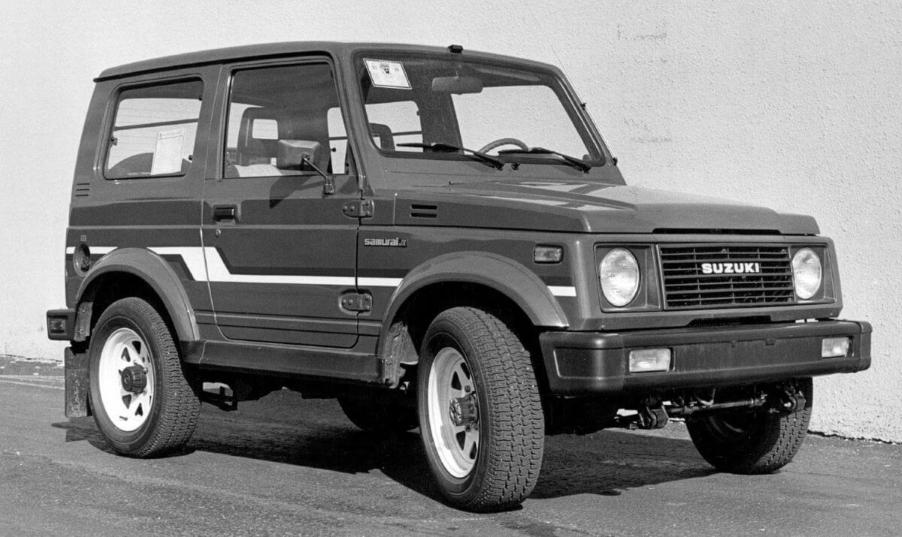
1 Consumer Reports Test Killed Sales of the Suzuki Samurai in the U.S.
The Samurai was a solid hit for Suzuki in the 1980s, selling close to 100,000 units a year by 1988. It was popular with off-road enthusiasts, young buyers, and anyone looking for a simple, inexpensive vehicle. For a time, they were everywhere, from offroad trails to shopping malls. Until seemingly overnight, they vanished.
Looking at the Samurai, you could argue that it was too slow, small, or crude for the U.S. market. However, the same could be said about the Jeep Wrangler. You could also argue that the rising yen made it too expensive, and there is some truth to that because the base price rose from $6,550 in 1986 to $8,495 in 1988. However, the real killer was an article published by Consumer Reports in June 1988.
A brief history of the Jimny and Samurai

The Samurai was based on the Suzuki Jimny, a small, rugged 4×4 that began as a kei-class Jeep knockoff. It looked like a scaled-down Willys Jeep and offered the same rugged simplicity. By 1981, Suzuki was exporting the Jimny to different markets in Asia, Australia, and Europe under names like Suzuki SJ410/413, Samurai, Sierra, Chevrolet Samurai, Holden Drover, and Maruti Gypsy. Then in 1985, it set its sights on the U.S.
For the U.S. market, Suzuki used the Samurai name and provided it with a 63-hp 1.3-liter four-cylinder engine, according to MotorTrend. Other changes included a new grille with revised headlights and taillights. Buyers could order dealer-installed options like air conditioning and a stereo, but the Samurai never strayed from the Jimny’s rugged, spartan roots.
Even though it got the Jimny’s largest engine, performance was slow. It took almost 17 seconds to get to 60 mph from a standstill, reaching the quarter mile in 20.5 seconds with a speed of 65 mph. However, if you think that’s slow, imagine the Samurai with the Jimny’s 550cc three-cylinder engine, which produced as little as 28 horsepower.
Consumer Reports called the Suzuki Samurai ‘unsafe’
In 1988, the Consumer Reports magazine tested the Suzuki Samurai and rolled it under what it said were “normal” driving conditions. During the publication’s crash avoidance and lane change tests, the little SUV refused to stay on all four wheels. As a result, they gave the Samurai an “unacceptable” rating calling it unsafe and saying it easily rolled over.
However, Consumer Reports wasn’t done. It mounted a safety campaign against the Samurai, showing reporters videos of the vehicle on outriggers to prevent it from rolling over. In the videos, a test driver put the Samurai through its paces, causing it to tip over on the outriggers at speeds above 40 mph. Consumer Reports also petitioned the National Highway Transportation Safety Administration to issue a recall. However, the NHTSA refused because it already required vehicles like the Samurai to carry warning labels advising drivers and passengers that the vehicles are more likely to roll over than normal cars.
Once Consumer Reports published its review of the Samurai, sales of the little Jeep-like vehicle cratered. Suzuki offered the vehicle with generous rebates, made changes like revising the suspension and widening the track of the vehicle, and published its own findings. Still, it was to no avail.
The Samurai departed and Suzuki sued
The Samurai left the U.S. for good in 1995, never to return, even though the Jimny it’s based on is still sold elsewhere. The Consumer Reports article not only led to its demise but it directly affected sales of other Suzuki vehicles.
In 1996 Suzuki sued Consumer Reports for damages based on its review and ratings about the Samurai. At the heart of the case was Consumer Reports’ statement that the Samurai “easily rolls over in turns.” Suzuki was adamant about the Samurai’s safety, insisting it performed well under normal conditions. It cited government findings that Samurai’s real-world rollover accident performance was comparable to other utility vehicles. Additionally, the NHTSA criticized Consumer Reports’ test methods citing driver variation and some extreme methods used in its findings.
Eventually, the lawsuit was settled out of court. Both parties reached a mutual understanding and agreed not to refer to the Samurai testing or rating or their litigation in any advertising or promotional material. Subsequent versions of the Jimny have received several changes to improve the safety and performance of the vehicle. Still, it’s unlikely the Samurai or another variant of the Jimny will ever return to the U.S.




